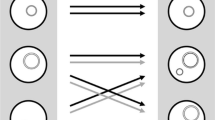Abstract
I suggest a common population genetic mechanism that explains persistence of biological species as consistently reproducing groups of similar organisms: genetic renewal due to genetic drift or selection, which restricts genetic diversity of populations. In contrast to concepts explaining species integrity via interbreeding, the concept of drift- and selection-induced genetic renewal explains species existence not only for sexually reproducing organisms, but also for asexual, or agamous, organisms. I redefine concepts of population, isolation and species in terms of genetic renewal. The proposed concept of renewing species develops Alan Templeton’s cohesion species concept.


Similar content being viewed by others
Notes
For simplicity, in this example with mtDNA, I don’t consider interspecific mtDNA introgression. We will take a look at what happens in case of such introgression and, in general, in case of lateral gene transfer (LGT), in the end of the article.
REFERENCES
Fontaneto, D. and Barraclough, T.G., Do species exist in asexuals? Theory and evidence from bdelloid rotifers, Integr. Comp. Biol., 2015, vol. 55, no. 2, pp. 253–263.
Futuyama, J., Evolution, Sunderland: Sinauer, 2005.
Gillespie, J.H., Population Genetics: A Concise Guide, Baltimore: Johns Hopkins Univ. Press, 1998.
Hedrick, P., Population Genetics and Ecology, Levin, S., Ed., Princeton: Princeton Univ. Press, 2009, pp. 109–116.
Holman, E.W., Recognizability of sexual and asexual species of rotifers, Syst. Zool., 1987, vol. 36, pp. 381–386.
Li, C.C., The First Course in Population Genetics, Pacific Grove, CA: Boxwood, 1976.
Mayr, E., Systematics and the Origin of Species, New York: Columbia Univ. Press, 1942.
Paterson, H.E.H., The recognition concept of species, in Species and Speciation, Vrba, E., Ed., Transvaal Museum Monograph no. 4, Pretoria: Transvaal Mus., 1985, pp. 21–29.
Rosselló-Móra, R. and Amann, R., Past and future species definitions for Bacteria and Archaea, Syst. Appl. Microbiol., 2015, vol. 38, no. 4, pp. 209–216.
Templeton, A., The meaning of species and speciation: a genetic perspective, in Speciation and Its Consequences, Daniel, O. and Endler, J.A., Eds., Sunderland: Sinauer, 1989, pp. 3–27.
Templeton, A., Haplotype trees and modern human origins, Am. J. Phys. Anthropol., 2005, vol. 41, pp. 33–59.
Valen van, L., Ecological species, multispecies, and oaks, Taxon, 1976, vol. 25, pp. 233–239.
Wilkins, J., Philosophically speaking, how many species concepts are there? Zootaxa, 2011, vol. 2765, pp. 58–60.
Author information
Authors and Affiliations
Corresponding author
Ethics declarations
Conflict of interest. The author declares that he has no conflict of interest.
Statement of the welfare of animals. This article does not contain any studies involving animals or human participants.
Rights and permissions
About this article
Cite this article
Pshenichnov, A. The Renewing Species. A Common Population-Genetic Explanation of Species Phenomena for Sexual and Asexual Organisms. Biol Bull Rev 9, 385–392 (2019). https://doi.org/10.1134/S2079086419050074
Received:
Revised:
Accepted:
Published:
Issue Date:
DOI: https://doi.org/10.1134/S2079086419050074




